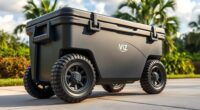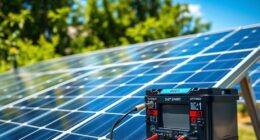To prepare a thorough power outage emergency kit, include battery-powered flashlights, solar lanterns, and LED lights for reliable illumination. Add solar chargers and portable power banks to keep your devices charged, especially phones and radios. Keep spare batteries and organize cables for quick setups. Make certain solar chargers are placed in sunny spots and check their functionality regularly. For more tips on staying prepared, explore further details below to enhance your safety and peace of mind.
Key Takeaways
- Include reliable battery-powered flashlights, spare batteries, and LED lanterns for versatile lighting options.
- Pack solar chargers, portable power banks, and compatible cables to ensure continuous device charging.
- Ensure all electronics, such as cell phones and radios, can be recharged via solar solutions.
- Organize accessories and place solar chargers in sunny spots for optimal recharging during outages.
- Maintain regular checks of equipment and establish backup plans combining solar and battery-powered devices.

During a power outage, having a well-prepared emergency kit can make all the difference between chaos and safety. One of the most essential items to include is a reliable source of emergency lighting. Battery-powered flashlights are a must-have, but you should also consider investing in solar chargers and solar-powered lanterns. Solar chargers are invaluable because they harness sunlight to keep your devices powered without relying on traditional electricity sources. This way, you can keep your cell phone, radio, or other critical electronics charged and functional, even during prolonged outages. Emergency lighting options like solar lanterns or LED lanterns provide bright, sustainable illumination that can be used indoors or outdoors, reducing the risk of accidents and helping you maintain a sense of normalcy. You should prioritize a variety of lighting options to ensure you’re covered in different scenarios. Solar-powered flashlights and lanterns are particularly useful because they recharge during the day, giving you a renewable source of light at night. These items are lightweight, portable, and easy to operate, making them ideal for both home use and emergency situations outside. Keep spare batteries for your battery-powered lights, but don’t rely solely on them. Solar lighting minimizes the need for battery replacements and ensures you always have a backup plan. When setting up your emergency kit, place your solar chargers in a sunny spot so they can recharge efficiently for the next outage. Additionally, solar energy storage solutions like portable power banks can help store excess solar energy for use during cloudy days or nighttime. In addition to lighting, having a plan for how to use your solar chargers effectively will save you time and frustration. Make sure your devices are compatible with the solar chargers you select. Keep cables and adapters organized and accessible, so you’re ready to power up quickly when the power goes out. Also, consider installing portable solar chargers that can be taken outside or used in different areas of your home. This flexibility ensures your essential devices stay operational, and your communication lines remain open. With the right combination of solar chargers and emergency lighting, you’ll be better equipped to navigate the uncertain moments during a power outage. It’s not just about having supplies; it’s about making sure those supplies function when you need them most. Proper setup and maintenance of these items will help you stay safe, informed, and connected, no matter how long the power remains out.
Frequently Asked Questions
How Often Should I Update My Emergency Kit?
Ever wondered how often you should update your emergency kit? You should review and refresh it at least once a year, aligning with your replacement schedule. Check the shelf life of items like food, water, and batteries, and replace expired supplies promptly. Regular updates ensure your kit remains reliable and ready for any power outage. Don’t wait until an emergency strikes—stay proactive and keep your kit current!
Are There Specific Items for Medical Needs?
Yes, you’ll want to include essential medical supplies like bandages, antiseptics, and any prescribed medications. If you or someone else has mobility aids such as crutches or a wheelchair, make sure to have spare batteries or backups ready. Keep a list of medical needs, including allergies and emergency contacts. Regularly check and update these items to guarantee they’re functional and current, so you’re prepared for any power outage situation.
How Do I Store My Emergency Supplies Safely?
You should store your emergency supplies in a cool, dry, and easily accessible location to guarantee storage safety. Use clear containers or labeled bins for kit organization, so you can quickly find what you need during an outage. Avoid areas prone to moisture or extreme temperatures, and regularly check your supplies for expiration or damage. Proper storage safety and organized kits help you stay prepared and respond effectively in an emergency.
What Are the Best Portable Lighting Options?
Imagine illuminating your entire home with just a tiny, portable device—solar lanterns and LED flashlights are your best bets. Solar lanterns charge during the day and shine brightly at night without batteries, making them perfect for emergencies. LED flashlights are compact, durable, and provide powerful beams. Both options are lightweight, easy to carry, and guarantee you never stumble in the dark during a power outage.
How Can I Make My Kit Eco-Friendly?
You can make your kit eco-friendly by choosing supplies made from sustainable materials and opting for eco-friendly packaging. Use reusable containers, biodegradable wipes, and solar-powered or hand-crank flashlights instead of disposable batteries. Select products with minimal plastic packaging and look for brands committed to environmental responsibility. This approach reduces waste, conserves resources, and guarantees your emergency kit is both effective and environmentally conscious during power outages.
Conclusion
A well-prepared emergency kit is your best defense during a power outage, like a sturdy umbrella in a storm. Keep it stocked and easily accessible, so you’re ready to face unexpected blackouts with confidence. Regularly check your supplies and update them as needed, ensuring you’ll stay safe and comfortable. Remember, preparedness is the key to weathering any storm—think of it as your personal shield against the dark.








